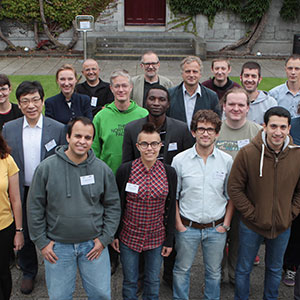-
Cúrsaí

Cúrsaí
Tá roghnú cúrsa léinn ar cheann de na cinntí is tábhachtaí dá ndéanfaidh tú choíche! Féach na cúrsaí atá againn anseo agus an méid a deir mic léinn agus léachtóirí faoi na cúrsaí sin a bhfuil spéis agatsa iontu.
-
Saol na hOllscoile

Saol na hOllscoile
Chuile bhliain roghnaíonn os cionn 4,000 duine Ollscoil na Gaillimhe mar chéad rogha. Faigh amach faoin saol in Ollscoil na Gaillimhe anseo.
-
Eolas Fúinn

Eolas faoi Ollscoil na Gaillimhe
Bí ar an eolas faoin Ollscoil seo agus na fáthanna a bhfuil sí chomh speisialta sin – an stair thar a bheith spéisiúil a bhaineann leis an Ollscoil agus an nuacht is déanaí agus na hócáidí atá ar na bacáin.
-
Coláistí & Scoileanna
- Scoil na Tíreolaíochta, na Seandálaíochta agus Léann Éireannaigh
- Coláiste an Ghnó, an Bheartais Phoiblí & an Dlí
- Coláiste an Leighis, an Altranais & na nEolaíochtaí Sláinte
- Coláiste na hEolaíochta agus na hInnealtóireachta
- Scoil na dTeangacha, na Litríochtaí agus na gCultúr
- Roinn na Gaeilge
- An tAcadamh
- Stair
- Idirnáisiúnta

Coláistí & Scoileanna
Tá aitheantas idirnáisiúnta bainte amach ag Ollscoil na Gaillimhe mar ollscoil atá á treorú ag an taighde agus rún daingean aici teagasc den chéad scoth a chur ar fáil i réimsí éagsúla saineolais.
-
Taighde

Nithe Fónta á gCruthú as Smaointe Úra
Tugann ár dtaighdeoirí aghaidh ar chuid de na dúshláin is práinní san 21ú Céad.
-
Gnó & Tionscal

Tacaíocht do Thaighde Úrnua in Ollscoil na Gaillimhe
Déanaimid deiseanna tráchtála a chuardach agus a chothú don phobal taighde in Ollscoil na Gaillimhe, mar aon le comhpháirtíocht tionsclaíochta a chothú.
-
Alumni, Cairde & Lucht Tacaíochta

Alumni, Cairde & Lucht Tacaíochta
Tá os cionn 90,000 céimí de chuid Ollscoil na Gaillimhe ann ar fud an domhain. Déan nasc linn agus beidh teacht agat ar an gcomhphobal sin ar líne.
-
Rannpháirtíocht Pobail

Rannpháirtíocht sa Phobal
In Ollscoil na Gaillimhe, creidimid go n-éireoidh níos fearr leat más féidir leat an méid a fhoghlaimíonn tú a chur i bhfeidhm i do shaol féin. Is mar gheall air sin go bhfuil béim mhór ar shocrúcháin oibre nó ar thionscadail phobail i gcuid mhór dár gcúrsaí.
Nuacht
Irish academic appointed Chief Scientist of Food and Agriculture Organization of the UN
A University of Galway academic has been appointed Chief Scientist of the Food and Agriculture Organization (FAO) of the United Nations. Charles Spillane is Established Professor of Plant Science in the School of Biological and Chemical Sciences and Ryan Institute and leads the AgriBiosciences, Food Security and Climate Change research lab in the University. Professor Spillane joins the Core Leadership team of the Food and Agriculture Organization - the inter-governmental specialised agency within the United Nations system which leads international efforts to defeat hunger and achieve food security for all. It is the first time an Irish person has been appointed to such a high leadership position in the FAO since its foundation in 1945. The mission of the FAO is focused on three goals: the eradication of hunger, food insecurity and malnutrition; the elimination of poverty and the driving forward of economic and social progress for all; and the sustainable management and utilisation of natural resources, including land, water, air, climate and genetic resources for the benefit of present and future generations. Minister for Agriculture, Food, Fisheries and the Marine, Martin Heydon T.D., said: “The appointment of Professor Charles Spillane as Chief Scientist of the Food and Agriculture Organization of the United Nations is a significant achievement for Ireland, the University of Galway and for Professor Spillane personally. He brings deep expertise in agricultural bioscience, climate-resilient food systems and sustainability, built through decades of leading interdisciplinary research at the University of Galway. His appointment will further strengthen the FAO’s capacity to advance evidence-based innovation and partnerships for resilient, inclusive and sustainable agrifood systems worldwide.” Professor David Burn, President of University of Galway, said: “We are delighted that Professor Spillane has been appointed to this position of exceptional public service with the United Nations Food and Agriculture Organization. Professor Spillane’s appointment to this globally leading role is a testament to University of Galway’s rapidly growing reputation in agricultural research and education for food security and international development, that has been achieved over the past decade.” Professor Charles Spillane, University of Galway, said: “I am deeply honoured to be appointed as Chief Scientist within the Food and Agriculture Organization of the United Nations. I am taking on this role with profound respect for the Organization’s remarkable history and enduring mandate to achieve food security for all, and to ensure that people everywhere have regular access to sufficient, nutritious food. The Food and Agriculture Organization is a key enabler of the world’s shared commitment to a simple but powerful idea, namely that that no person should go hungry, and that the pursuit of food security is inseparable from the pursuit of peace, prosperity, and dignity.” The Food and Agriculture Organization is the United Nation’s lead agency for SDG2 (Sustainable Development Goal 2) - Zero Hunger and is the custodian agency responsible for 21 of the United Nation’s Sustainable Development Goal indicators. It was founded in 1945 in response to the multiple global food crises that followed World War II. It is governed by its 195 members, namely 194 Member States and the European Union, operating on a consensus-based one country, one vote system. Ireland is one of the Member States, where the Department of Agriculture, Food and the Marine leads the state’s engagement. The FAO has an annual budget of over US$2billion, with more than 16,000 staff working across the headquarters in Rome, five regional offices and 130 country offices. Read more information about the Food and Agriculture Organization of the United Nations here: www.fao.org.Ends
Student awarded inaugural A.Menarini scholarship for diabetes research
All-Ireland Peatlands Centre of Excellence launched
Researchers unlock secrets of spinal disc degeneration
Friday, 16 December 2022
All eligible University of Galway full time and part time hourly payscales have been updated in line with the provisions of Building Momentum - A New Public Service Agreement 2021-22. Specifically the following increases have been implemented: - With effect from 02nd February 2022, payscales received a 3% increase - With effect from 01st October 2022- payscales received a further 1% increase or €500, whichever is greater We are still awaiting sanction for the implementation of FEMPI restoration wef 1st July 2022 (save for a limited number of pay scales). Therefore there are no changes to those grades\pensions for now. See paragraph 1.3 in the above link for more details. Further advice will be issued for these grades in due course.
Monday, 24 April 2023
We have been asked to bring to your attention the fact that Secondment Expression of Interest Notices has been issued for the Public Service Transformation Division of the Department of Public Expenditure, NDP Delivery and Reform. Expressions of interest are invited from across all sectors of the Public Service, including higher education, and across a number of grades. Notices are available directly at the following link, and DPENDR and DFHERIS would very much appreciate your support in circulating to your staff. The closing date for applications is 2nd May, and we understand the notices issued on Friday 14th April.









